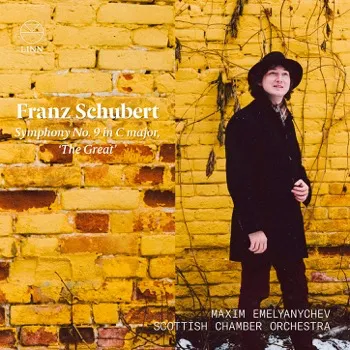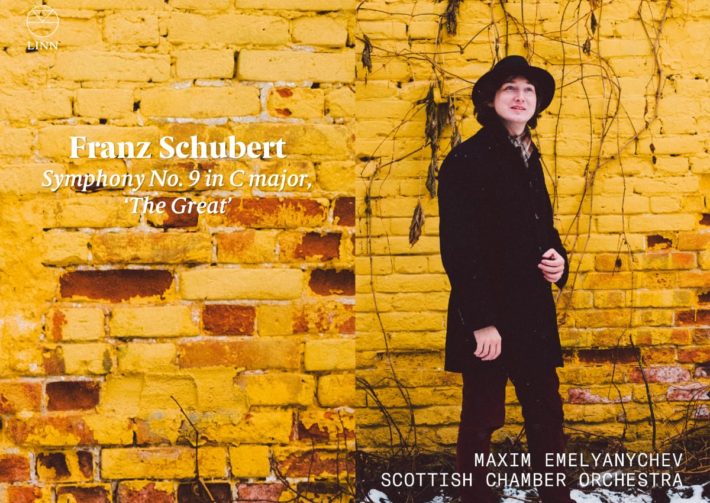In their first recording together, the Scottish Chamber Orchestra and their new Chief Maxim Emelyanychev take on Schubert’s Ninth Symphony, “The Great”. This symphony has been a subject of contention among music historians, sparking debates about its genre and style. Is it a Classical symphony in the vein of Beethoven, or does it herald the dawn of the Romantic era, paving the way for composers like Berlioz and Brahms?

The Scottish Chamber Orchestra comes to this Schubert Symphony with a rich history of playing symphonic music in a chamber style. Their string sections are small, and they use period instruments where appropriate (here, natural brass and timpani). Emelyanychev arrives having led both period-instruments and chamber groups such as Il Pomo d’Oro and Nizhny Novgorod Soloists Chamber Orchestra, who’s Beethoven and Brahms album was reviewed in these pages. It isn’t surprising, then, that the Scottish Chamber Orchestra and Emelyanychev end up distinctly on the Classical side of the debate. Yet their playing goes beyond historically informed practice. It becomes something entirely contemporary.
The famous opening motif is played simply here. The Classical style comes through in attentive, Beethoven-esque sforzandos and unadorned phrasing. It’s at the arrival of the movement’s main theme, though, that Emelyanchev’s unusual interpretation begins to take shape (track 1, 3’13”). The tempo is quite quick. The players shape the dotted melody so that the emphasis is strongest on the very first note, placing the focus on the rhythm rather than the melody.
The second theme is similar; the accents will be overdone for some ears, but it’s certainly consistent with the musical perception (4’00”). The entire movement has a dance feel that takes its inspiration from Baroque. The strings and winds play incredibly sharp staccatos, that at times seem to create a one-beat-per-bar feel. On the other hand, there is something very modernist in Emelyanychev’s focus on shapes and contours, in his giving the rhythm pride of place in a piece full of such wonderful lyricism.
It’s worth comparing Emelyanychev’s first movement to Claudio Abbado and the Chamber Orchestra of Europe’s 1988 recording (or in less degree to his re-do with the Orchestra Mozart). Just the first three notes of the horn line in Abbado’s recording establish the differences. The 30-second long phrase, played with incredible warmth, might as well be a 30-page manifesto. Abbado takes an unabashedly Romantic view of the piece. The introduction is legato and luxurious. The main and secondary themes are more traditionally melodic, and accents do not stand out so distinctly. The differences are so stark between Abbado and Emelyanychev that I hesitate to make value judgments, but the one spot where I sense a distinct advantage for Abbado is in the music’s more unsettled moments. The trombones’ tense variations on the introductory horn line are wonderful in Abbado’s, whereas with this Linn recording they feel rushed. They are played beautifully, but the gesture doesn’t quite fit.
Emelyanychev’s creativity continues in the Andante con moto. The tempo is again rather quick, and the soloists alternate between hyper-staccato, dance-like playing and lyric, though never drawn-out, melodies. The fortes are tight and played with impressive strength. In the B section, tutti chords that spell out the section’s motif become vast, separate brushstrokes, rather than lyrical expressions (track 2, 3’10”). The countermelody that leaps up and down becomes acrobatic and pointed. The result is quite busy, sonically speaking, but effective, and the orchestra plays particularly well, giving the music an unstoppable sense of pulse. Abbado’s recording has a distinct advantage only in the most lyrical spot in the movement, where a solo horn and unstable strings send us back to the first theme.
The Scherzo and Trio form a study in contrasts, and Emelyanychev doesn’t lose the opportunity despite the blistering tempos. The Scherzo is, like the Andante, dry and exaggerated, the brass providing heavy but sharp, staccato accents, the arpeggio figures are more dance-like than lyrical. Here, you can hear Emelyanychev’s technical strategy most clearly: space before the accents is key. He and the Scottish Chamber Orchestra have mastered the use of silence, if only in millisecond slices. In the Trio, we get melodies, but never Brahms or Mahler-length lines. Each phrase is short and self-contained; the tied notes at ends of phrases often stop a few quarter notes early compared with Abbado.
Very few dare to take the thrilling Finale so quickly, risking it will become unplayable. This movement arises naturally from Emelyanychev’s leadership; it fits soundly within the style of the rest of the recording, without much alteration from standard performance practice. However, some will find the coda a bit mannered. The music is mysterious, but the tempo leaves no room for it. The downbows are truly impressive (13’43”), but the theme hasn’t been about weight in the rest of the movement. The four notes have bounced, and now they stomp.
Even with these reservations, this thought-provoking album is a wonderful addition to the Schubert catalog, but beyond that, to the growing body of work that is changing how we listen to music of the Baroque and Classical eras, highlighting the similarities rather than the differences. The Scottish Chamber Orchestra players have not lost their touch under Emelyanychev, and the recording quality and balance are aligned with Linn Record’s usual high standards. Strongly recommended for any fan of this work, especially listeners who can approach this performance with an open mind.
Schubert Symphony No. 9 (“The Great”) – Recommended Comparisons
Schubert – Symphony No. 9 (“The Great”)
Scottish Chamber Orchestra
Maxim Emelyanychev – Conductor

Album Details |
|
|---|---|
| Album name | Schubert – Symphony No. 9 (“The Great”) |
| Label | Linn Records |
| Catalogue No. | CKD 619 |



















